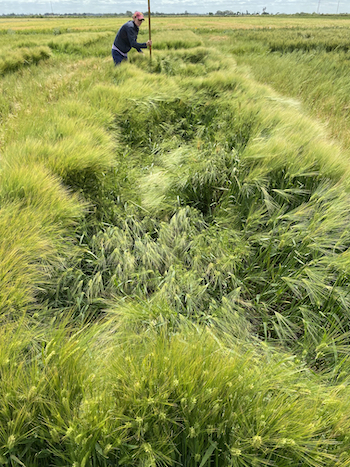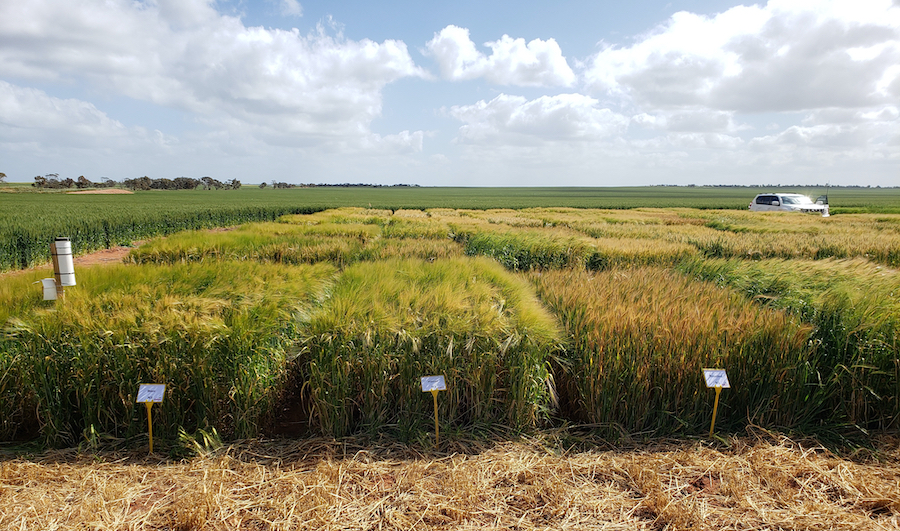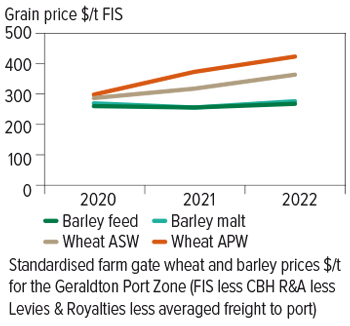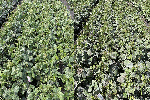Diverse issues relating to barley crops are being explored through National Grower Network (NGN)-driven projects.
Closing the yield gap
By Tom Price and Nick Poole, Field Applied Research Australia
 Strategies relating to canopy management are being investigated to close barley yield gaps. Photo: FAR Australia
Strategies relating to canopy management are being investigated to close barley yield gaps. Photo: FAR Australia
Growers in the low and medium-rainfall zones of the southern and northern regions have identified crop canopy constraints that prevent maximum attainable yield in barley. These constraints all relate to canopy characteristics such as head loss, brackling (stem buckling) and lodging control, plus disease management.
This in-the-field reporting contrasts with computer simulations that generally ignore canopy characteristics and suggest sowing time and nitrogen deficit are the biggest factors leading to a yield gap.
In the high-rainfall zones, however, recent research found that of these two possibilities – nitrogen versus canopy – it was actually canopy management that explained yield responses ranging from three to eight tonnes per hectare (based on studies that contrasted similar genetics). The management practices include the use of fungicides, time of sowing and use of plant growth regulators (PGRs).
To identify the true drivers of barley yield gaps in the low and medium-rainfall zones, GRDC invested in two NGN-driven projects that are led by Field Applied Research (FAR) Australia.
These projects involve a series of replicated field trials designed to compare yield response to different management practices. Variables being investigated include:
- different barley varieties – RGT Planet, Cyclops and Leabrook;
- time of sowing;
- nitrogen and canopy management through fungicides, PGRs and simulated grazing treatments; and
- PGR treatments to avoid head drop and lodging.
A key feature of the approach being taken is coordinating trials between the low-rainfall and medium-rainfall areas. By combining the operating plan for both investments it becomes possible to analyse three diverse agro-ecological zones that have yield potentials ranging from two to 7t/ha with the same treatments, varieties and measurements. The environments in these studies encompass:
- Birchip, Victoria: low-rainfall zone with two to 4t/ha yield potential;
- Hart, SA: medium-rainfall zone with a dryland yield potential of three to 6t/ha;
- Daysdale, NSW: medium-rainfall zone with a dryland yield potential of three to 7t/ha.
Measurements will include climate data, canopy temperature, soil sampling, normalised difference vegetation index (NDVI) data using GreenSeeker, phenology data, disease assessments, crop height, yield and quality plus observable yield-limiting factors such as lodging, brackling and head loss.
Trials started in autumn 2021, with the projects due for completion in 2024. Interested growers can attend field days planned for September at each of the sites or engage with trial results through Online Farm Trials or visit the project page on the GRDC website.
More information: Tom Price, [email protected]
Agronomic strategies in the Geraldton Port Zone
By Barrett Sinclair and Peter Carlton, Kalyx Australia
In WA’s Geraldton port zone, many growers are unsure how to manage a barley crop compared with wheat and how it fits within their farming system. Through grower surveys, a need for information about barley management and agronomic packages was identified.
This project tested different barley types against different nitrogen management options with early and late sowing opportunities in different environments.

Trials in Geraldton Port Zone have found that barley can be grown successfully in this region but cannot compete with wheat financially. Photo: Kalyx Australia
Six barley varieties were grown in small plot trials over three years in soils typical of WA’s northern wheatbelt. The varieties were RGT Planet, Spartacus CL, Rosalind, Buff, Bass and Scope CL, which provided a range of maturities, herbicide tolerance, market end use and acid tolerance levels.
The wheat variety Sceptera was included to provide yield and gross margin comparisons.
The plots were subjected to site-specific nitrogen strategies that tested:
- whether nitrogen was best applied all prior to seeding or split with an early and post-emergent application; and
- if a higher rate was beneficial in above-average seasons.
The plots were then tested for yield, grain quality and profitability against a well-adapted wheat. The project found that barley can be grown successfully in this region and can match wheat yields (and even produce a yield advantage).
However, barley could not compete with wheat financially as the first-choice cereal in a crop rotation. The yield benefit was not large enough, in the duration of this project, to overcome the price premium for wheat.
The three seasons sampled varied greatly in rainfall, the timing of rainfall and maximum temperatures during grain fill. However, extreme finishes with hot, dry winds and high spring temperatures were not encountered.
The 2020 growing season experienced decile 2-3 rainfall yet most sites experienced season-saving rainfall in August. This was accompanied by as many as 39 days above 30˚C during the grain-fill period.
Substantial autumn rainfall provided an ideal start to the 2021 growing season to test early sowing opportunities. Consistent cold fronts through July helped to maintain a high yield potential at each site. The grain-fill period experienced steadily increasing maximum temperature from mid-August.
In 2022, it was an average growing season judged by total rainfall, yet cold fronts through July and August allowed crops to compensate for low rainfall through May and June. August rainfall was accompanied by mild temperatures and temperatures greater than 30˚C were not recorded until the end of September.
Barley varieties were identified that consistently performed well across the three years. RGT Planet did well when sown early at Tenindew and West Casuarinas, while Rosalind was better-suited to later sowing at these sites. Bass and RGT Planet were suited to early sowing at Northampton and Eradu.
A later sowing at Northampton showed no specific advantage for any barley. Buff was the best-performing barley on the acid sands locations such as at Binnu and Canna over the three years of the trial and was also suited to the later sowing at Eradu.
Malt-grade barley was successfully produced in the trials (at Binnu, Northampton and Tenindewa) but malt grain cannot currently be delivered to CBH facilities in the Geraldton port zone.
In general, applying all nitrogen upfront, prior to seeding, was a robust nitrogen strategy for the yellow sands at Binnu and the loam soil of Northampton. An active nitrogen strategy was more likely to be beneficial at Eradu, Tenindewa, Canna and West Casuarinas.
Barley yield was comparable to wheat at each site in 2021 and 2022 but cannot compete with wheat financially as the first-choice cereal in a crop rotation. The yield benefit was not large enough to overcome the price premium for wheat over the duration of this project. In 2021, the loss ranged from $49/ha to $528/ha at Eradu, Tenindewa and Canna (Figure 1).
Figure 1. Farmgate grain prices for wheat and barley for 2020-22.

Source: Kalyx Australia
Barley sown early could be more profitable, such as at Binnu and Northampton in 2021 and Tenindewa in 2022, yet this was on the back of a 1.1 to 2t/ha yield advantage and wheat failing to reach a premium grade.
Although barley cannot compete with wheat as a first-choice cereal, its ability to flower before August might make it a low-risk and profitable option as a third cereal before a break crop in a mixed-farming enterprise where the extra stubble has value for animals or as an option on acid soils.
Imidazolinone tolerance could provide a specific fit for growers and barley’s vigorous growth habit for weed competitiveness also offers advantages.
More information on trial results can be viewed at GRDC’s Online Farm Trial website.
Trial data was analysed by Statistics for the Australian Grains Industry (SAGI) West and economic analysis was performed by Agrarian Management.
Kalyx would like to acknowledge GRDC, Agrarian Management, SAGI West and the trial hosts for their valuable input.
More information: Barrett Sinclair, [email protected]
Lodging mitigation using plant growth regulators
By Matthew Gardner, AMPS Research
Lodging has been identified as a production constraint for barley crops in high-yielding seasons in the northern grain region.
Currently, the use of a plant growth regulator (PGR) on dryland barley crops in northern NSW is estimated to be less than five per cent of the area and generally used only in five to 20 per cent of seasons (decile 8 or above).
Consultants and growers have cited variable and unreliable outcomes from the use of PGRs as a barrier to wider use in dryland barley. Instead, they rely on other management tools to manage lodging, such as paddock and varietal selection, nutrition management and time of sowing.
In some instances, lower-yielding varieties with better straw strength are selected over high-yielding varieties that are susceptible to lodging.
This project in northern NSW aims to better understand the use of PGRs in barley to increase confidence in their use and reduce the variability in responses by developing more-robust guidelines for the best situations to use them.
Led by AMP Research, PGR trials were conducted at Liverpool Plains, Gurley and Tulloona during 2022, a season that was highly conducive to barley lodging.
The study found that net returns could be increased by up to $699/ha in response to PGR treatment. However, lodging and yield responses varied, indicating that matching PGR treatment to variety and seasonal conditions is critical.
In all, four varieties were tested at the three trial sites: Leabrook, Laperouse, RGT Planet; and Maximus CL. These varieties differed in their response to PGRs, with Leabrook proving highly responsive to all PGR treatments at Gurley, where lodging scores nearly halved (from 7.5 to less than 4.0) following PGR treatment.
However, the response to PGRs varied between sites. For example, lodging scores for Leabrook at Spring Ridge remained between five and three regardless of PGR treatment.
When comparing PGR treatments:
- All varieties responded to ethephon but improvement in lodging varied, with the largest response in Laperouse.
- The Moddus® (Trinexapac-ethyl) early and Moddus late treatments could also reduce lodging scores, but the effect was inconsistent across varieties and sites.
When comparing yield, Leabrook was most responsive to PGR treatment, with yield increasing by up to 2.2t/ha for the most effective PGR applications at Spring Ridge and 1.2t/ha at Gurley. Overall, the late application of Moddus had one of the largest benefits when averaged across the sites, increasing yield by 0.9 to 2.2t/ha at Spring Ridge, 0.11 to 1.1t/ha at Gurley and 0.28t/ha at Tulloona.
When comparing impacts on gross margins at Spring Ridge:
- Leabrook margins increased in response to all the PGR treatments, averaging between $183/ha and $384/ha.
- Early single applications of Moddus could also increase yield and margins, but not consistently; and
- Across all four varieties, Moddus applied late increased partial gross margins by $136/ha to $384/ha.
At Gurley, the financial benefits followed a similar trend, but impacts were smaller. For example, late applications of Moddus at Gurley changed returns by -$13/ha to $271/ha, while the most effective treatment increased partial gross margins by -$4/ha to $303/ha.
Overall, the 2022 trials indicate that while substantial increases in yield and net returns can be achieved in response to PGR treatment, a greater understanding is needed of the interaction with variety, environment and management practices. Trials in 2023 are exploring these interactions to further refine understanding of the yield response and risks associated with the most-effective treatments.
Four trials are underway in 2023 that are assessing nine PGR treatments across a range of sowing time, plant available nitrogen and soil water. The trials are also addressing three key areas when it comes to selecting a PGR treatment:
- Despite variable yield results, ethephon remains a potential PGR treatment given the low product cost. Therefore, the trial is exploring crop safety and yield benefits in different environments.
- Understanding how Moddus applications can be manipulated through single or double applications, application timing and rate to maximise yield benefits.
- Evaluation of alternative PGRS that are yet to be registered for use in barley.
More information: Matthew Gardner, [email protected]
Lodging mitigation on the Darling Downs
By Majella Bathurst, Censeo Field and Lab
On Queensland’s fertile Darling Downs, the best barley yielding seasons can often end in lodging and head loss, making a potential six to 8t/ha crop a headache for harvesters and leading to losses of up to 30 per cent.
This is an example of a regionally specific problem brought to the attention of GRDC through local NGN groups.
Participants at the Brigalow Grower Group NGN Forum reported significant crop losses in the 2021-22 season when barley growers in Queensland lost an estimated $10 million due to lodging.
With their understanding of local soils and conditions, they asked GRDC for support to evaluate agronomic solutions that fit their needs. Specifically, could management of rapid growth in the early and late vegetative periods reduce lodging and head loss, without reducing yield potential?
A GRDC investment made it possible for Censeo Field and Lab to investigate the use of commercial plant growth regulators (PGRs) to manage periods of excessive growth, extend the grain filling period, better manage crop standability and increase crop yield.
Three trial sites have been established on the Western Downs and the inner Darling Downs where barley lodging has been a problem: Jandowae (Caloola Farm), Oakey (Devon Park, irrigated) and Warra.
PGR treatment protocols will only use commercially available products (Ethephon and Trinexapac Ethyl) within the confines of their label use.
Barley varieties were selected based on growers’ preferences and include:
- Planet: mid-season, high yield spring barley that is adaptable to early or late season finishes;
- Yeti: the highest-yielding variety in the northern region, with a vigorous plant type and reduced height;
- Leabrook: a medium-tall barley with early maturing and high yield; and
- Maximus: a high-yielding, quick-mid maturing, imidazolinone-tolerant barley, with a short coleoptile and erect plant type.
The trials will be assessed for lodging, yield, grain quality, grain fill, ear size, days to flowering and crop height.
More information: Majella Bathurst, [email protected]

























































